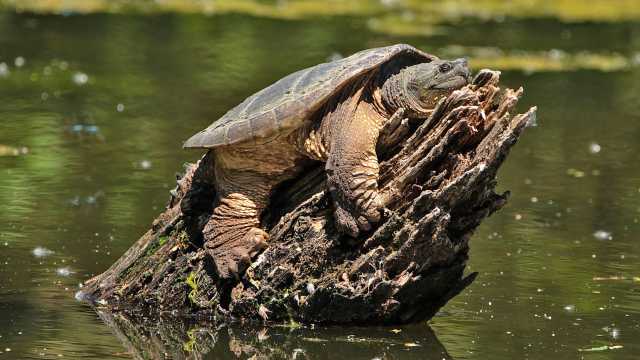By Paige Filice and Alexa Warwick, Michigan State University Extension
Michigan’s lakes, streams, and wetlands are home to 10 species of turtles that are frequently spotted in the spring basking and nesting.
Painted turtles are Michigan’s state reptile and are commonly spotted basking on top of logs on sunny days.
Turtles are a unique and easily recognizable group of animals that have been around since the time of dinosaurs. It might come as a surprise, but their shell is made up of their rib bones. Like other reptiles, turtles rely on their environment to regulate their temperature, which is why they are often seen warming themselves on floating logs. One fascinating fact about turtles is that temperature also determines whether a turtle hatchling is male or female.
Michigan’s turtles are found in a broad range of habitats including woodlands, rivers, and lakes. During the summer you are most likely to spot the painted turtle, red-eared slider, and common map turtle. More rare and threatened species in Michigan include the Blanding’s turtle, eastern box turtle, wood turtle, and spotted turtle.
Turtles are negatively affected by a variety of human activities such as polluted water runoff, habitat loss, and vehicle collisions. Many turtles rely on the shoreline areas of lakes and wetlands for nesting and basking, and frequently these areas are the most developed, e.g., seawalls.
Turtles often leave the water in search of nesting sites and to find new habitat and thus may be killed or injured when crossing roads. Their nests are also frequently raided by predators such as raccoons and foxes, which consider their eggs a delicacy.
Species snapshot: Common snapping turtle (Chelydra serpentina)
Known for their dinosaur-like appearance and powerful jaws, the common snapping turtle (Chelydra serpentina) is a frequent lake inhabitant and Michigan’s largest turtle species. Their top shell, also known as a carapace, can reach 20 inches in length.
As their name implies, this species is common throughout Michigan and most of the eastern and southern United States.
Although snapping turtles have a reputation for an aggressive demeanor, they often only react defensively when provoked. They spend most of their life in the water and frequently flee from confrontation. Unlike many turtles, they are unable to pull their head or legs into their shell for protection. Their main defense mechanism is their mouth.
Snapping turtles are more elusive than some of Michigan’s other turtle species and rarely bask on logs. They have snorkel-like nostrils at the very tip of their snout and are very good at camouflaging. Sometimes they can be spotted in shallow waters on sunny days with their shells near the surface.
Snapping turtles eat both aquatic plants and animals and like other turtles, they do not have teeth. They are ambush predators and typically bury in the mud and wait for unsuspecting prey to approach them. They will eat anything that will fit in their mouth including fish, frogs, and reptiles. In lake ecosystems they are also important aquatic scavengers.
Did a snapping turtle nest in your yard?
If you are lucky enough to spot a snapping turtle, it’s likely in late May to early July as females leave the water to find nesting sites. Don’t be alarmed; snapping turtles do not hunt on land. They may display defensive behaviors while laying their eggs such as hissing or snapping their mouth when approached. When left undisturbed, they do not pose a threat.
If you are fortunate enough to see a snapping turtle nesting, sit back and enjoy the show! It usually only lasts about a half hour.
When creating a nest, they will dig a hole with their back legs and guide eggs with their hind feet into the hole. They then cover the eggs for incubation and protection. The eggs will take approximately two months to hatch, although the length of time is weather dependent. The nest will be left unguarded which is typical for most reptiles.
Did you find a turtle?
Don’t be concerned if the turtle is away from water. Turtles travel over land to reach new habitat, find food, and for breeding purposes.
—Keep wildlife wild. It is not advisable to keep wild turtles as pets and in some instances, it is also illegal to possess them.
Submit a Michigan Natural Features Inventory Rare Species Form if the turtle is one of Michigan’s four rare species (Blanding’s turtle, eastern box turtle, wood turtle, and spotted turtle).
—Move a turtle crossing the road in the same direction it was heading.
How to safely handle turtles
—Never pick up a turtle by its tail or drag it across the ground. Doing so risks injuring its vertebral column, leaving it unable to survive in the wild.
—The best way to move a turtle to safety is to grasp the shell behind the back legs. Turtles can also be moved on a tarp or blanket. Be cautious of their claws and mouth; snapping turtles have a very flexible neck.
—Always wash your hands after touching turtles.
A version of this article originally appeared in the May 2023 issue of the Lakefront Lifestyles magazine.
To contact an expert in your area, visit extension.msu.edu/experts, or call 888-MSUE4MI (888-678-3464).







